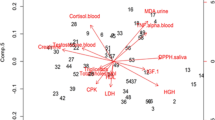Abstract
Objective
The decline in antioxidant defenses due to both estrogen loss and frequent adoption of poor dietary choices exposes postmenopausal women to cardiovascular diseases. Adequate nutrition and physical exercise are two factors of health promotion. This study investigated whether regular practice of mind-body exercise (yoga and/or tai chi) alters dietary intake and antioxidant status and balances the menopause related increases in lipid peroxidation and cardiovascular risk.
Design
Cross-sectional study. Setting: The study was conducted in an urban community in Bangkok (Thailand) between May and August 2007.
Participants
Premenopausal (Pre M; 39±8 yrs; n=56) and postmenopausal (Post M; 54±5 yrs; n=39) women who had been practicing yoga (Y) and/or tai chi (TC) more than 3 hours/week for a year, or who had no regular physical activity practice (sedentary, S).
Measurements
All participants completed food frequency questionnaires and 4-day food and activity records. Blood was collected on day 5. Factorial ANOVA tests were performed according to menopause status, exercise, and hormone replacement therapy (HRT) groups.
Results
Post M had higher (p = 0.01) dietary fiber intake compared with Pre M. Yoga practitioners had lower BMI (p = 0.004) and lower fat intake (p = 0.02) compared with their S and TC counterparts. Plasma total antioxidant status was significantly and independently lower and higher in Y and Post M groups, respectively. However, no difference was shown after adjusting for BMI. Regardless of menopause status and HRT, the activity of erythrocyte glutathione peroxidase an aerobic training responsive enzyme was higher (p < 0.001 ) in TC practitioners compared with other groups. No effects were shown on erythrocyte superoxide dismutase activity, plasma lipid peroxidation (TEARS) or total homocysteine concentrations.
Conclusion
Yoga and tai chi exercises can be used as components of a strategy to promote healthy lifestyles (balanced diet and moderate intensity exercise) in vulnerable populations, such as menopausal women, in order to prevent aging induced oxidative stress diseases.
Similar content being viewed by others
References
Rousseau AS, Margaritis T, Arnaud J, Faure H, Roussel AM. Physical activity alters antioxidant status in exercising elderly subjects. J Nutr Biochem 2006; 17:463–470.
Tessier F, Margaritis I, Richard MJ, Moynot C, Marconnet P. Selenium and training effects on the glutathione system and aerobic performance. Med Sci Sports Exerc 1995;27:390–396.
Margaritis I, Rousseau AS, Hininger I, Palazzetti S, Arnaud J, Roussel AM. Increase in selenium requirements with physical activity loads in well-trained athletes is not linear. Biofactors 2005; 23:45–55.
Rousseau AS, Robin S, Roussel AM, Ducros V, Margaritis I. Plasma homocysteine is related to folate intake but not training status. Nutr Metab Cardiovasc Dis 2005; 15:125–133.
Rousseau AS, Hininger I, Palazzetti S, Faure H, Roussel AM, Margaritis I. Antioxidant vitamin status in high exposure to oxidative stress in competitive athletes. Br J Nutr 2004; 92:461–468.
Margaritis I, Rousseau AS. Does physical exercise modify antioxidant requirements? Nutr Res Rev 2008;21:3–12.
Kosulwat V. The nutrition and health transition in Thailand. Public Health Nutr 2002;5:183–189.
Palasuwan A, Soogarun S, Lertlum T, Pradniwat P, Wiwanitkit V. Inhibition of Heinz body induction in an in vitro model and total antioxidant activity of medicinal Thai plants. Asian Pac J Cancer Prev 2005; 6:458–463.
Jiwajinda S, Santisopasri V, Murakami A, Kim OK, Kim HW, Ohigashi H. Suppressive effects of edible Thai plants on superoxide and nitric oxide generation. Asian Pac J Cancer Prev 2002; 3:215–223.
Charoenkiatkul S, Kosulwat V, Chavasit V, Kosulwat S, Rojroongwasinkul N, Boonpraderm A. Nutritive values of healthy Thai foods J Natl Res Council Thailand 2003;35:1–59.
Innes KF, Selfe TK, Taylor AG. Menopause, the metabolic syndrome, and mind-body therapies. Menopause 2008; 15:1005–1013.
Lan C, Chen SY, Lai JS. The exercise intensity of Tai Chi Chuan. Med Sport Sci 2008;52:12–19.
Muktibodhananda S. Hatha Yoga Pradipika New Delhi, India: Thomson Press India; 1985.
Soules MR, Sherman S, Parrott E, et al. Executive summary: Stages of Reproductive Aging Workshop (STRAW). Fertil Steril 2001; 76:874–878.
Le Moullec N, Deheeger M, Preziosi P. et al. Validation du manuel photos utilisé pour l’enquête alimentaire de l’étude SU.VI.MAX. (Validation of the photo manual used for the collection of dietary data in the SU.VI.MAX Study). Cah Nutr Diet 1996; 31:158–164 (in French).
Ainsworth BE, Haskell WL, Whitt MC, et al. Compendium of physical activities: an update of activity codes and MET intensities. Med Sci Sports Exerc 2000; 32:S498–504.
Re R, Pellegrini N, Proteggente A, Pannala A, Yang M. Rice-Evans C. Antioxidant activity applying an improved ABTS radical cation decolonization assay. Free Radic Biol Med 1999; 26:1231–1237.
Satoh K. Serum lipid peroxide in cerebrovascular disorders determined by a new colorimetric method. Clin Chim Acta 1978; 90(1):37–43.
Schoppen S, Carbajal A, Perez-Granados AM, Vivas F, Vaquero MP. Food, energy and macronutrient intake of postmenopausal women from a menopause program. Nutr Hosp 2005; 20:101–109.
Kwanbunjan K, Chaikate S, Songmuaeng K. Assessment of Dietary Patterns of Thais in Germany and Thailand. Mal J Nutr 2005; 11 89–98.
Le Lay S, Ferre P, Dugail I. Adipocyte cholesterol balance in obesity. Biochem Soc Trans 2004; 32:103–106.
Pansini E, Cervellati C, Guariento A, et al. Oxidative stress, body fat composition, and endocrine status in pre- and postmenopausal women. Menopause 2008; 15:112–118.
Pedersen SB, Kristensen K, Hermann PA, Katzenellenbogen JA, Richelsen B. Estrogen controls lipolysis by up-regulating alpha2A-adrenergic receptors directly in human adipose tissue through the estrogen receptor alpha Implications for the female fat distribution. J Clin Endocrinol Metab 2004; 89:1869–1878.
Nutrition Division Department of Health Ministry of Public Health. The Fourth National Nutrition Survey of Thailand 1995. Bangkok: War Veterans Organization Printing; 1997.
Bednarek-Tupikowska G, Tworowska U, Jedrychowska I, Radomska B, Tupikowski K, Bidzinska-Speichert B, Milewicz A. Effects of oestradiol and oestroprogestin on erythrocyte antioxidative enzyme system activity in postmenopausal women. Clin Endocrinol (Oxf) 2006; 66(4):463–468.
Wang C, Collet JP, Lau J. The effect of Tai Chi on health outcomes in patients with chronic conditions: a systematic review. Arch Intern Med 2004; 164:493–501.
Espinola-Klein C, Ruppreeht HI, Bickel C, et al. Glutathione peroxidase-1 activity, atherosclerotic burden, and cardiovascular prognosis. Am J Cardiol 2007; 99:808–812.
Palazzetti S, Rousseau AS, Richard MJ, Favier A, Margaritis I. Antioxidant supplementation preserves antioxidant response in physical training and low antioxidant intake. Br J Nutr 2004; 91:91–100.
Fuchs O. Effects of intracellular chelatable iron and oxidative stress on transcription of classical cellular glutathione peroxidase gene in murine erythroleukemia cells. Neoplasma 1997; 44:184–191.
Wang JS, Lan C, Wong MK. Tai Chi Chuan training to enhance micro circulatory function in healthy elderly men. Arch Phys Med Rehabil 2001; 82:1176–1180.
Cortese-Krott MM, Suschek CV, Wetzel W, Kroncke KD, Kolb-Bachofen V. The nitric oxide-mediated protection of endothelial cells from hydrogen peroxide is mediated by intracellular zinc and glutathione. Am J Physiol Cell Physiol 2009.
Sharma H, Datta P, Singh A. et al. Gene expression profiling in practitioners of Sudarshan Kriya. J Psychosom Res 2008; 64:213–218.
Author information
Authors and Affiliations
Corresponding author
Rights and permissions
About this article
Cite this article
Palasuwan, A., Margaritis, I., Soogarun, S. et al. Dietary intakes and antioxidant status in mind-body exercising pre- and postmenopausal women. J Nutr Health Aging 15, 577–584 (2011). https://doi.org/10.1007/s12603-011-0060-2
Received:
Accepted:
Published:
Issue Date:
DOI: https://doi.org/10.1007/s12603-011-0060-2




